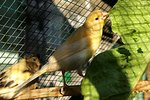
Ringneck doves are one of the few species of birds delegated to living in captivity. Although they're descended from extant species of African doves, ringnecks are so domesticated that they no longer have the instincts to survive in the wild. When it comes to mating, their rituals are similar to those of their wild cousins -- but they have to rely on their humans for nesting structures.
Nesting Behavior
Ringneck doves make haphazard nests that can sometimes appear to be tangled piles of small sticks, straw or hay. They prefer to build their small nests in some sort of open container or shelf; they're not cavity nesters like some other species. A small shelf or shallow, open box, placed high in the aviary, will provide an ideal nesting site. Clean, pliable twigs, hay and straw are ideal nesting materials. Once a nesting location is chosen, the male will begin his courting ritual to entice the female of his liking.
Three Coos
Male ringneck doves start the courting ritual, as is common in many bird species. In a large aviary, these acts will allow the males to find their life mates. A captive male will also perform these acts if only one female is around. Although their courting dances aren't flamboyant, they do perform three distinctive acts when breeding season arrives. The first act is a series of coos in which the male will announce to the rest of the doves in the area that he is ready to mate. He'll sit on a perch and let out his announcement coos. After he's scoped out the females and finds one he's interested in, he'll perform a slightly elaborate bow-and-coo combination in which he bows in front of the female while cooing. If she accepts his advances, he will then go sit on the nesting site, bow, coo and slightly flutter his wings.
Egg Laying
Females lay eggs frequently -- sometimes as often as every three weeks -- beginning at approximately 8 months old. Females will lay eggs whether they've mated or not. Unfertilized clutches contain four eggs on average; fertilized clutches often contain only two eggs. Approximately a week after copulation, the female lays her eggs. The couple take turns incubating for approximately two weeks until the young doves hatch. A bonded pair will mate throughout the year and produce numerous clutches. If you choose to keep ringneck doves in captivity as pets, choose a female pair, a single dove or separately caged doves to prevent breeding.
Baby Birds
Both parents feed their young crop milk, or the sloughed lining of their upper digestive pouch, during the first few days. Once the babies are a few days old, both the mother and father will begin regurgitating digested seeds for their babies. Fledging occurs within two weeks; the young are mature enough to leave their parents at approximately 1 month old.
References
Photo Credits
-
Comstock Images/Stockbyte/Getty Images
Writer Bio
With a professional background in gardening, landscapes, pests and natural ecosystems, Jasey Kelly has been sharing her knowledge through writing since 2009 and has served as an expert writer in these fields. Kelly's background also includes childcare, and animal rescue and care.




